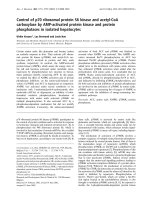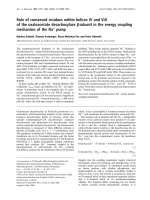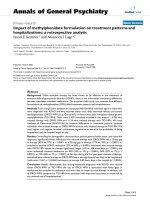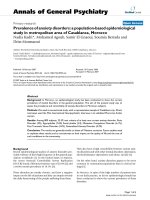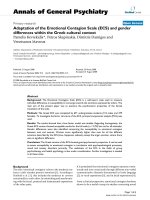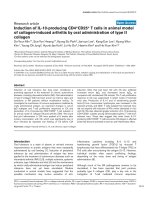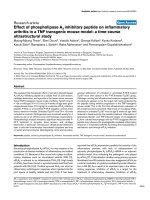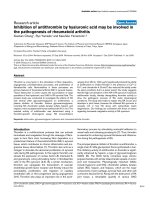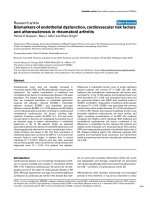Báo cáo y học: "Phylodynamics of HIV-1 Circulating Recombinant Forms 12_BF and 38_BF in Argentina and Uruguay" pps
Bạn đang xem bản rút gọn của tài liệu. Xem và tải ngay bản đầy đủ của tài liệu tại đây (807.93 KB, 9 trang )
RESEARC H Open Access
Phylodynamics of HIV-1 Circulating Recombinant
Forms 12_BF and 38_BF in Argentina and
Uruguay
Gonzalo Bello
1*
, Paula C Aulicino
2
, Dora Ruchansky
3
, Monick L Guimarães
1
, Cecilio Lopez-Galindez
4
,
Concha Casado
4
, Hector Chiparelli
3
, Carlos Rocco
2
, Andrea Mangano
2
, Luisa Sen
2
, Mariza G Morgado
1
Abstract
Background: Although HIV-1 CRF12_BF and CRF38_BF are two epidemiologically important recombinant lineages
circulating in Argentina and Uruguay, little is known about their population dynamics.
Methods: A total of 120 “CRF12_BF-like” and 20 “CRF38_BF-like” pol recombinant sequences collected in Argentina
and Uruguay from 1997 to 2009 were subjected to phylogenetic and Bayesian coalescent-based analyses to
estimate evolutionary and demographic parameters.
Results: Phylogenetic analyses revealed that CRF12_BF viruses from Argentina and Uruguay constitute a single
epidemic with multiple genetic exchanges among countries; whereas circulation of the CRF38_BF seems to be
confined to Uruguay. The mean estimated substitution rate of CRF12_BF at pol gene (2.5 × 10-3 substitutions/site/
year) was similar to that previously described for subtype B. According to our estimates, CRF12_BF and CRF38_BF
originated at 1983 (1978-1988) and 1986 (1981-1990), respectively. After their emergence, the CRF12_BF and
CRF38_BF epidemics seem to have experienced a period of rapid expansion with initial growth rates of around
1.2 year
-1
and 0.9 year
-1
, respe ctively. Later, the rate of spread of these CRFs_BF seems to hav e slowed down
since the mid-1990s.
Conclusions: Our results suggest that CRF12_BF and CRF38_BF viruses were generated during the 1980s, shortly
after the estimated introduction of subtype F1 in South America (~1975-1980). After an initial phase of fast
exponential expansion, the rate of spread of both CRFs_BF epidemics seems to have slowed down, thereby
following a demographic pattern that resembles those previously reported for the HIV-1 epidemics in Brazil, USA,
and Western Europe.
Background
The AIDS epidemic in South America is caused by mul-
tipl e HIV-1 group M subtypes including subtypes B, F 1,
and C, in addition to BF1 and BC recombinant forms.
The BF1 recombinants represent the most widespread
geneticformaftersubtypeBandreachahighpreva-
lence (10%-50%) in countries from t he Southern Cone
(Argentina, Brazil, Chile, Paraguay, and Uruguay) [1-14].
Genetic characterization of BF1 recombinants in
South America revealed some important differences
across countries. Although four distinct BF1 circulating
recombinant forms (CRFs) have been described in Brazil
to date (CRF28_BF, CRF29_BF, CRF39_BF, and
CRF40_BF) [15,16], the Brazilian BF1 epidemic is largely
dominated by a variety of unique recombinants forms
(URFs) that do not share a common recombinant ances-
tor [7,10,17-19]. In contrast, the Argentine BF1 epi-
demic comprises the widespread CRF12_BF and several
URFs with a CRF12-related structure [6,8,20,21]. The
molecular epidemiology of HIV-1 in Uruguay is not so
well characterized, but two previous studies suggested
that BF1 recombinants circulating in this country are
similar to those described in Argentina [3,20]. Very
recently, a novel CRF3 8_BF1 was described among Uru-
guayan HIV-1 isolates, indicating that other BF1
* Correspondence:
1
Laboratório de AIDS & Imunologia Molecular, Instituto Oswaldo Cruz -
FIOCRUZ, Rio de Janeiro, Brazil
Bello et al. Retrovirology 2010, 7:22
/>© 2010 Bel lo et al; li censee BioMed Ce ntral Ltd. This is an Open Access article distributed under the terms of the Creative Commons
Attribution License ( which permits unrestricted use, distribution, and reproduction in
any medium, provid ed the original wor k i s properly cited.
recombinants besides CRF12_BF have gained epidemic
importance in this country [14].
Previous studies performed by our group suggest that
theHIV-1subtypeF1andBF1epidemicsinSouth
America were initiated after the introduction of a single
F1 strain into Brazil between the middle and late 1970s
[22-24]. After it s introduction, this founder subtype F1
strain probably recombined with the local subtype B
virus generating the la rge diversity of CRFs_BF1 and
URFs_BF1 currently observed in the continent [24].
Based on monophyletic clustering and coincident
recombination breakpoints, it was suggested that most
BF1 recombinants circulating in Argent ina and Uruguay
derived from a common recombinant ancestor
[21,24,25].
To date, however, very little is known about the evolu-
tionary history and epidemic potential of the diverse
BF1 recombinants that have expanded in the South
American population. Only one previous study was con-
ducted on a small number (n = 40) of CRF12_BF-like
vpu sequences from a vertically in fected population in
Argentina [26]. This study estimated the age of the
most recent common ancestor (MRCA) of tho se
CRF12_BF-like viruses between 1981 and 1996, and
further suggests an extremely rapid spread of the
CRF12_BF-like recombinant viruses, compatible with
the demographic pa ttern of explosive population growth
observed in this pediatric population at the start of the
epidemic.
The objective of the present study was to reconstruct
the evolutionary and demographic history of the
CRF12_BF circulating in Argentina and Uruguay
through the analysis of a large data set (n =120)of
CRF12_BF-like pol sequences recovered from ad ults and
children living in both countries. In addition, we also
analyzed a small data set (n = 20) of CRF38_BF-like pol
sequences to estimate the age and demographic history
of the CRF38_BF epidemic spreading in Uruguay. This
data represent an excellent opportunity to explore
potential CRF-specific and regional-specific differences
in the patterns of HIV-1 epidemic growth in South
America.
Methods
Study population
A total of 66 and 17 samples with a CRF12_BF-like
and CRF38_BF-like mosaic pattern at the po l gene,
respectively, were selected from HIV-1-infected
patients residing in Argentina and Uruguay who had
previously been analyzed in two independent studies.
ThefirststudyanalyzedthegeneticstructureofBF1
pol recombinant sequences collected between 1997 and
2008 from HIV-1 infected children followed up at the
“ Hospital de Pediatria Garrahan” in Buenos Aires,
Argentina, identifying 43 samples with a CRF12_BF-
like mosaic pattern (Aulicino et al,publicationinpro-
gress). The second study assessed the genetic diversity
in a group of BF1 pol recombinant samples collected
between 1997 and 2009 from HIV-1 infected adults
and children residing in Uruguay, identifying 2 3 sam-
ples with a CRF12_BF-like mosaic structure and 17
samples with a CRF38_BF-like mosaic pattern
(Ruchansky et al, publication in progress). These
unpublished sequences were combined with CRF1 2_BF
(Argentina n =3;Uruguayn = 2) and CRF38_BF (Uru-
guay n = 3) reference sequences, and CRF12_BF-like
pol sequences ( Argen tina n =48;Uruguayn =1)from
adults patients with known sampling dates retrieved
from the Los Alamos HIV Sequence Database http://
www.hiv.lanl.gov/content/index, as described in
Table 1. Sequences were excluded if they originated
from the same patient or from individuals known to be
related by direct transmission. The sequences were
~1440 bp long and covered the protease (PR)andpart
of the reverse transcriptase (RT) g enes (nucleotid es
2266-3705 relative to the HXB2 clone), encompassing
the recombinant fragments of the CRF12_BF and
CRF38_BF at pol gene (Fig. 1a). Nucleotide sequences
were aligned using CLUSTAL X program [27]. All
positions with alignment gaps were excluded from
analyses.
Table 1 HIV-1 CRF12_BF and CRF38_BF data sets.
CRF_BF Year New Database Total References
12 1997 7 3 10 [21]
1998 9 - 9
1999 4 8 12 [20,21]
2000 5 - 5
2001 0 20 20 [6]
2002 6 - 6
2003 8 12 20 [9]
2004 6 11 17 [8]
2005 5 - 5
2006 4 - 4
2007 2 - 2
2008 10 - 10
Total 66 54 120
38 1997 1 - 1
1998 2 - 2
1999 2 - 2
2000 1 - 1
2003 8 1 9 [14]
2004 1 1 2 [14]
2005 1 1 2 [14]
2009 1 - 1
Total 17 3 20
Bello et al. Retrovirology 2010, 7:22
/>Page 2 of 9
Figure 1 Virus analyses. a) Genomic mosaic structure of CRF12_BF and CRF38_BF viruses. Green, subtype F1; blue subtype B; white, unknown
subtype. Numbers above breakpoints refer to nucleotide positions in the HXB2 genome. Vertical dotted lines indicate the pol gene fragment
(nucleotides 2266-3705) used in the present study. b) Majority-rule Bayesian consensus tree of the pol gene of HIV-1 CRFs_BF circulating in
Argentina (red), Uruguay (blue), and Brazil (black). Posterior probability values are indicated only at key nodes. Brackets indicate the monophyletic
clusters formed by each CRF. Boxes indicate the two Uruguayan sub-cluters identified within the CRF12_BF clade. Positions of the full-length
characterized CRF12_BF and CRF38_BF reference sequences are marked with asterisks. The tree was rooted on midpoint and horizontal branch
lengths are drawn to scale with the bar at the bottom indicating 0.03 nucleotide substitutions per site. Representative bootscanning plots of the
pol gene fragment of CRF12_BF (A32879) and CRF38_BF (UY03_3389) reference sequences are depicted on the right. Reference sequences used
for these analyses were as follows: subtype B (BZ126, blue), subtype F1 (BZ167, green), subtype C (92BR025, gray) and subtype A1 (U455, red).
Bello et al. Retrovirology 2010, 7:22
/>Page 3 of 9
Characterization of “CRF-like” recombinant profiles
Two strategies were used to characterize the HIV-1 pol
sequences used in the present study as CRF12_BF-like
or CRF38_BF-like recombinants:
1) First, the recombination breakpoints of each
sequence were identified by Bootscanning using Simplot
version 3.5.1 [28]. Bo otstrap values support ing branch-
ing with reference sequences were determined in Neigh-
bor-Joining (NJ) trees constructed using the K2-P [29]
nucleotide substitution model, based on 100 re-sam-
pling s, with a 200 bp sliding window moving in steps of
20 bases. Individual query sequences were compared to
representative reference sequences of HIV-1 subtypes
A1,B,C,andF1.Sequenceswereconsideredtohavea
“CRF-like” profile if recombination sites exactly match
those identified in CRF12_BF and CRF38_BF reference
sequences.
2) Second, Bayesian and Maximum Likelihood (ML)
phylogenetic trees for the final pol alignment including
all CRF-like sequences were built to confirm the overall
topology and strong support of each CRF clade. Phylo-
genetic trees were constructed under the GTR [30]
nucleotide substitution model, with a gamma-distribu-
tion model of among site rate heterogeneity and a pro-
portion of invariable sites (GTR+I+Γ) select ed using the
Modeltest program [31]. A Bayesian phylog eny was esti-
mated using MrBayes [32]. Two runs of four chains
each were run for 50 × 10
6
generations, with a burn-in
of5×10
6
generations. Convergence of p arameters was
assessed by calculating the Effec tive Sample Size (ESS)
using TRACER v1.4 [33], after excluding an initial 10%
for each run. All parameter estimates for each run
showed ESS values >100. ML trees were reconstructed
with PhyML [34] using an online web server [35]. Heur-
istictreesearcheswereperformedusingtheSPR
branch-swapping algorithm, and the approximate likeli-
hood-ratio test (aLRT) based on a Shimodaira-Hase-
gawa-like procedure was used as a statistical test to
calculate branch support. Trees were visualized with the
FigTree v1.1.2 program (available at http://tr ee.bio.ed.ac.
uk/software/figtree/).
Estimation of evolutionary rates, dates, and demographic
history
Theevolutionaryrate(μ, units are nucleotide substitu-
tions per site per year), the age of the most recent com-
mon ancestor (T
mrca
, years), and the mode and rate (r,
years
-1
)ofpopulationgrowthfortheCRF12_BFand
CRF38_BF strains were estimated using BEAST v1.4.7
[36,37]. Evolutionary and demographic parameters of
CRF12_BF were estimated under a chronological time-
scale empl oying the dates of sample collection. The low
number of CRF38_BF sequences analyzed (i.e., 20
sequences), however, was not sufficient to obtain an
accurate estimate of the evolutionary rate of this lineage.
Therefore, the rates of evolution at pol (PR/RT)gene
previously estimated for other HIV-1 group M subtypes
(1.5 × 10
-3
-2.5×10
-3
substitutions/site/year) [38-41]
were incorporated as a prior probability distribution in
the analysis of this CRF. Estimations of evolutionary and
demographic parameters involved two steps. First, the
Bayesian s kyline plot method [42] was used to estimate
μ,theT
mrca
, and the change in effective population size
through time. Second, two different demographic mod-
els for ea ch data set were compared: exponential and
logistic growth; and estimates o f the population growth
rate were then obtained under the m odel that provided
the best fit to the demographic signal in each data set.
Model comparisons in a Baye sian framework were per-
formed by calc ulating the Baye s Factor (BF) [43] with
TRACER v1.4. Analyses were performed using the
GTR+I+Γ nucleotide substitution model under either
strict or uncorrelated Lognormal relaxe d [44] molecular
clock models. Two separate MCMC chains were run for
10-50 × 10
6
generations, with a burn-in of 1-5 × 10
6
.
BEAST output was analysed using TRACER v1.4, with
uncertainty in parameter estimates reflected in the 95%
Highest Probability Density (HPD) intervals. Conver-
gence of parameters was assessed through the ESS, with
all parameter estimates for each run showing ESS values
>100. A graphical representation of the effective number
of infections through time was generated by using pro-
grams TRACER v1.4 and Prism 4 (GraphPad Software).
Posterior trees samples from BEAST runs were sum-
marized using TreeAnnotator v1.4.7 (av ailable from
) to generate time-scaled maxi-
mum clade credibility trees.
Results
A total of 115 pol sequences (Argentina = 91, Uruguay
=24)witha“CRF12_B F-like” recombination profile,
and 17 pol sequences (Uruguay) with a “CRF38_BF-like”
recombinant pattern were identified by Bootscanning
analyses. These sequences were aligned with reference
sequences of CRF12_BF, CRF38_BF and Brazilian
CRFs_BF1, and analyzed using Bayesian and ML
approaches. B oth phylogenetic approaches showed that
the CRF12_BF-like and CRF38_BF-like pol sequences
segregated with their respective CRF reference
sequences in two well supported monophyletic groups
characteri zed by unique recombination profiles, con-
firming the common ancestry of each CRF (Fig. 1). Of
note, Simplot analysis suggests that the CRF38_BF pre-
sents a more complex BF1 mosaic pattern at the PR/RT
genomic region than that previously described [14],
characterized by the presence of small subtype F1 frag-
ments between positions 2640 and 3020 relative to
HXB2 (Fig. 1). More detailed analysis of the pol genomic
Bello et al. Retrovirology 2010, 7:22
/>Page 4 of 9
region should be performed in order to determine the
precise mosaic structure of the CRF38_BF at that region.
Within the CRF12_BF clade, two strongly supported
Uruguayan subclusters comprising four (cluster UY-1)
and six (cluster UY-2) viruses were identified in both
Bayesian (posterior probability [PP] > 0.80) (Fig. 1) and
ML (a LTR > 0.70) phylogenetic trees (data not shown ).
Most (61%) CRF12_BF Uruguayan sequences, however,
were randomly interspersed among Argentine
sequences, which provides evidence against the existence
of a specific Argentine or Uruguayan CRF12_BF lineage.
This contrasts with the circulation of CRF38_BF which
seems t o be restricted to Uruguay, as no strains with a
CRF38_BF-like structure were identified after analysis of
more than 300 B F1 recombinant pol sequences from
Argentina (74 unpublished sequences and 249 sequences
retrieved from the Los Alamos HIV Sequence Database).
Bayesian MCMC analyses under a skyline tree prior
were used to estimate the time-scale of the CRF12_BF
and CRF38-BF epidemics. The mean estimated evolu-
tionaryratefortheCRF12_BFpol gene was 2.4 × 10
-3
subst./s ite/year, under both strict and relaxed molecular
clock models (Table 2). The median rate of evolution
for the CRF38_BF pol gene was 1.8 × 10
-3
subst./site/
year (strict clock) and 1.9 × 10
-3
(relaxed clock),
although the 95% HPD intervals of those estimates
almost coincide with the informat ive prior interval
(Table 2), indicating that not much information was
added by the data. Considering these substitution rates,
the median T
mrca
of the CRFs was estimated at 1982
(strict clock) and 1983 (relaxed clock) for the
CRF12_BF, and 1985 (strict clock) and 1986 (relaxed
clock) for the CRF38_BF (Table 2).
Bayesian skyline plot analyses were also used to i nfer
the demographic history of South American CRF_BF
epidemics. According to this analysis the CRF12_BF epi-
demic experienced a fast exponential growth durin g the
first 10-15 years followed by a more recent decline in
growth rate since the mid-1990s (Fig. 2a). A very similar
demographic pattern was observed for the CRF38_BF,
showing that after an initial period of exponential
growth of ~10 years the growth rate of this CRF epi-
demic also slowed around the mid-1990s (Fig. 2b).
These results suggest that a model of logistic population
growth fits the demographic information contained in
the CRF12_BF and CRF38_BF data sets better than the
exponential growth model.
To test this hypothesis, approximate marginal log like-
lihoods for the logistic and exponential growth models
were calculated. The analysis of BF clearly showed that,
for both CRFs, the model of logistic population growth
was strongly supported over the exponential growth
model, under either a strict or a relaxed molecular clock
(Table 3). On the other hand, models assuming a
relaxed molecular clock fit the CRF12_BF and
CRF38_BF data sets better than models enforcing a
strict molecular clock (Table 3) indicating that substitu-
tion rate varies among branches consistent with other
HIV-1 studies [39,45-47]. Indeed, t he coefficients of
variation under the relaxed clock model were higher
than zero for both CRF12_BF (mean = 0.21, 95% HPD:
0.16-0.26) and CRF38_BF (mean = 0.28, 95% HPD:
0.10-0.46).
A c oalescent model of logistic growth was then used
to estimate the initial growth rate of South American
CRF_BF epidemics. Evolutionary parameters estimated
Table 2 Bayesian estimates of evolutionary parameters of the HIV-1 CRF12_BF and CRF38_BF epidemics.
Subtype Gene Coalescent Molecular clock μ Tmrca
CRF12_BF pol
Bayesian Skyline
Strict 2.4 × 10
-3
(1.9 × 10
-3
-2.9 × 10
-3
)
1982
(1976-1986)
Relaxed 2.4 × 10
-3
(1.8 × 10
-3
-3.1 × 10
-3
)
1983
(1978-1988)
Logistic growth
Strict 2.4 × 10
-3
(1.9 × 10
-3
-2.8 × 10
-3
)
1982
(1978-1986)
Relaxed 2.5 × 10
-3
(1.9 × 10
-3
-3.0 × 10
-3
)
1983
(1979-1987)
CRF38_BF
a
pol
Bayesian Skyline
Strict 1.8 × 10
-3
(1.5 × 10
-3
-2.2 × 10
-3
)
1985
(1977-1989)
Relaxed 1.9 × 10
-3
(1.5 × 10
-3
-2.3 × 10
-3
)
1986
(1981-1990)
Logistic growth
Strict 1.8 × 10
-3
(1.5 × 10
-3
-2.1 × 10
-3
)
1985
(1980-1989)
Relaxed 1.8 × 10
-3
(1.4 × 10
-3
-2.3 × 10
-3
)
1986
(1981-1990)
Estimates of the mean evolutionary rate (μ, substitutions site
-1
year
-1
) and median time of the most recent common ancestor (Tmrca, year) of the HIV-1 CRF12_BF
and CRF38_BF epidemics (95% HPD intervals in parentheses). The results reported are the combined estimates of two independent runs.
a
Informative prior
distribution of μ (1.5 × 10
-3
-2.5 × 10
-3
) for the CRF38_BF pol data set was selected from: Hué et al. [38], Salemi et al.[39], Bello et al.[40], and Passaes et al. [41].
Bello et al. Retrovirology 2010, 7:22
/>Page 5 of 9
under the logistic growth tree prior were almost identi-
cal to those estimated with Bayesian skyline (Table 2).
The mean estimated growth rate of CRF12_BF epidemic
was 1.08 year
-1
(strict clock), and 1.22 year
-1
(relaxed
clock). T his rate corresponds to a mean epidemic dou-
bling time of around six months (Table 4). The mean
growth rate of the CRF38_BF epidemic was estimated at
0.83 year
-1
(strict clock) and 0.92 year
-1
(relaxed clock),
which corresponds to a mean epidemic doubling time of
<1 year (Table 4).
Discussion
We have performed an extensive study of the evolution-
ary history and population dynamics of the two most pre-
valent HIV-1 BF1 recombinant strains (CRF12_BF and
CRF38_BF) spreading in South America. The CRF12_B F
was the first CRF to be described in South America
among samples isolated from Argentina and Uruguay
[20], and is responsible for a significant part of the
HIV-epidemics in those countries. Our phylogenetic ana-
lyses of recombinant pol sequences with a CRF12-like
Figure 2 Time-scaled Bayesian phylogenies and corresponding Bayesian skyline plots (BSP) for the HIV-1 CRF12_BF (a) and CRF38_BF
(b) epidemics. Time-scaled phylogenies and BSP were generated under a relaxed molecular clock model using BEAST. Branch lengths of the
trees represent time (see the time scale at the X-axis of each graph). BSP represent estimates of effective number of infections (Y-axis; log
10
scale) through time (X-axis; calendar years). Median (solid line) and upper and lower 95% HPD (dashed lines) estimates of the effective number
of infections are shown in each graph.
Table 3 Bayes Factors (BF) between exponential (Exp) and logistic (Log) growth demographic models for the HIV-1
CRF12_BF and CRF38_BF pol data sets.
Subtype Model comparison ln (BF)
a
Evidence against H
0
b
CRF12_BF
Exp (H
0
) vs Log (H
1
) Strict clock 111.7 (0.6) Decisive
Exp (H
0
) vs Log (H
1
) Relaxed clock 142.0 (0.7) Decisive
Log Strict (H
0
) vs Relaxed (H
1
) clock 48.0 (0.5) Decisive
CRF38_BF
Exp (H
0
) vs Log (H
1
) Strict clock 6.9 (0.3) Decisive
Exp (H
0
) vs Log (H
1
) Relaxed clock 10.5 (0.4) Decisive
Log Strict (H
0
) vs Relaxed (H
1
) clock 8.7 (0.3) Decisive
a
ln (BF) = Bayes Factor is the difference (in ln space) of the marginal likelihood of null (H
0
) and alternative (H
1
) model. The SE of the estimates is given in
parenthesis and was estimated using 1000 bootstrap replicates.
b
Evidence against H
0
was assessed in the following way: ln (BF) < 0 indicates no evidence
against the null model; ln (BF) between 0-2.3 indicates weak evidence against the null model, ln (BF) between 2.3-3.4 indicates strong evidence against the null
model; ln (BF) between 3.4-4.6 indicates very strong evidence against the null model; and ln (BF) > 4.6 indicates decisive evidence against the null model.
Bello et al. Retrovirology 2010, 7:22
/>Page 6 of 9
structure showed for the first time that CRF12_BF
viruses spreading in Argentina and Uruguay constitute a
single epidemic with evidences of multiple genetic
exchanges among countries. In contrast, circulation of
the recently described CRF38_BF [14] seems to be
restricted to Uruguay as no strains with a CRF38_BF-like
pol mosaic pattern were observed after screening of a
large number (n >300)ofBF1recombinantsequences
from Argentina.
According to our estimates, the mean T
mrca
of
CRF12_BF and CRF38_BF was 1982-1983 and 1985-
1986, respectively; only a few years later than the mean
estimated onset date of subtype F1 spread in Brazil
(1976-1978) [23,24]. These mean estimates are fully con-
sistent with epidemiological data that revealed that BF1
recombinants related to the CRF12_BF have been in cir-
culation in Argentine children since the mid 1980s [48].
In agreement with this study, we identified five Argen-
tine children born between 1987 and 1989 infected by
CRF12-like BF viruses, and one Uruguayan child born in
1987 infected by a CRF38-like BF strain.
Our study showed that the substitution rate of
CRF12_BF viruses at pol gene (2.5 × 10
-3
subst./site/
year) is similar to rates previously described for HIV-1
subtypes B, C, and CRF31_BC [38,40,41], pointin g to no
major differences in evolution rate amon g HIV-1 strains
circulating in South America. By contrast, some differ-
ences in epidemic growth rate may have existed across
distinct HIV-1 variants circulating in South America.
The estimated initial growth rate of the CRF12_BF epi-
demic in Argentina and Uruguay was higher than that
described for Brazilian subtype B, C, and F1 epidemics
[23,47], and similar to t hat recently described for th e
CRF31_BC viruses circulating in southern Brazil [47]
(Table 4); supporting the notion of a fast initial spread
of CRF12_BF-like viruses [26]. The initial expansion rate
of CRF38_BF also seems to be higher than those
described for subtypes B and F1, although the 95% HPD
interval of such an estimate was quite large (Table 4).
The rapid initial growth rate of CRF12_BF,
CRF31_BC, and CRF38 _BF epidemics in South America
may indicate that these CRFs displayed a higher fitness
and/or transmissibility than parental HIV-1 subtypes.
Alternatively, variations in the initial growth rate of
HIV-1 variants may reflect differences in the susceptible
pop ulations that characterized the initial spread of each
strain. Of note, the BF recombinants have been asso-
ciated with injection drug use populations in Argentina
and Uruguay [3,5 ], and introduction of a BF1 recombi-
nant virus in such highly connected networks may
explain the emergence and rapid initial dissemination of
the CRF_BF1 viruses.
After the initial period of fast exponential growth, the
expansion rate of the CRF12_BF and CRF38_BF epi-
demics slowed down since the mid 1990s. The same
demographic pattern was describe d for HIV-1 epidemics
inBrazil,USA,andsomeEuropeancountries
[23,38,47,49-51]. Such a recent decline in the growth
rate of these HIV-1 epidemics may be the consequence
of adequate prevention campaigns implemented after
the official report of the first AIDS cases in the early
1980s, and/or the result of a saturation of high-risk
transmission networks that are loosely connected with
low-risk subgroups that exhibit modest levels of HIV-1
infection [52].
The overall demographic pattern of the CRF12_BF
epidemic in Argentina and Uruguay observed in this
study is similar with that previously described for the
Table 4 Bayesian estimates of population dynamic parameters of the HIV-1 CRF12_BF and CRF38_BF epidemics.
Subtype Demographic model Molecular Clock Gene r l
CRF12_BF Logistic growth
Strict
pol (PR-RT)
1.08 (0.79-1.44) 0.64 (0.48-0.88)
Relaxed 1.22 (0.85-1.64) 0.57 (0.42-0.81)
CRF38_BF Logistic growth
Strict
pol (PR-RT)
0.83 (0.31-1.81) 0.83 (0.38-2.24)
Relaxed 0.92 (0.41-1.75) 0.75 (0.40-1.69)
CRF12_BF
a
Logistic growth Relaxed vpu 2.24 (0.21-4.56) 0.31 (0.15-3.30)
B
b
Logistic growth
Strict
env (C2-V3) 0.46 (0.33-0.59) 1.51 (1.22-2.10)
pol (PR-RT) 0.56 (0.35-0.80) 1.24 (0.87-1.98)
F
b
Logistic growth
Strict
env (C2-V3) 0.61 (0.40-0.86) 1.14 (0.81-1.73)
pol (PR-RT) 0.59 (0.31-0.92) 1.17 (0.75-2.24)
C
c
Logistic growth
Strict
pol (RT)
0.70 (0.41-1.00) 0.99 (0.69-1.69)
Relaxed 0.81 (0.40-1.26) 0.86 (0.55-1.73)
CRF31_BC
c
Logistic growth
Strict
pol (RT)
1.26 (0.61-2.10) 0.55 (0.33-1.14)
Relaxed 1.27 (0.44-2.26) 0.55 (0.31-1.57)
Estimates of the median growth rate (r,yr
-1
) and epidemic doubling time (l, yr) for the HIV-1 CRF12_BF and CRF38_BF epidemics (95% HPD in parentheses).
Growth rate estimates were used to calculate the time taken for the epidemic to double in size (l) using the relation l = ln(2)/r.
a
Data from Aulicino et al . [26].
b
Data from Bello et al. [23].
c
Data from Bello et al. [47].
Bello et al. Retrovirology 2010, 7:22
/>Page 7 of 9
CRF12_BF epidemic in Argentine children [26]; and our
mean estimates of T
mrca
and population growth rate fell
within the 95% HPD interval of the previous estimates
(Table 4). The confidence intervals of these new esti-
mates, however, were much narrower than those pre-
viously obtained (Table 4), indicating that the use of a
larger data set have substantially improved the accuracy
of parameter estimation. In agreement with this idea,
the small CRF38 data set was associated with much lar-
ger confidence intervals of d emographic parameter esti-
mates than those obtained fo r the larger CRF12_BF data
set. Thus, more precise estimations of demographic
parameters of CRF38_BF will require the analysis of a
larger number of sequences.
Conclusions
Our results suggest that CRF12_BF and CRF38_BF
viruses were rapidly generated aft er the introductio n of
subtype F1 into South America and have been circulat-
ing in the continent over the last 25 years. Both CRFs
seem to have spread exponentially at a fast rate during
the 1980s and the early 1990s; but the rate of spread of
the CRF12_BF and CRF38_BF viruses slowed down
since the mid 1990s. Despite similar emergence dates
and demographic histories, CRF12_BF have been widely
disseminated in Argentina and Uruguay, whereas the
CRF38_BF circulation w as found limited to Uruguay.
Determination of the factors that have shaped the pat-
tern and rate of spread of distinct HIV-1 variants in
South America is of paramount importance to under-
stand the epidemic potential of these variants.
Acknowledgements
We wish to thank Dr Edward C. Holmes and Dr Vera Bongertz for critical
reviewing of the manuscript. This study was supported by the Brazilian
CNPq/PROSUL grant 490585/2007-8. Work in the “Laboratorio de Biología
Celular y Retrovirus” was supported by the “Agencia Nacional de Promoción
Científica y Tecnológica” Award PICT 2004-25830, and CONICET Award PIP
6057. Work in the “Centro Nacional de Microbiología” was supported by
grants SAF 2005/03833 and SAF 2007/61036 of the “Plan Nacional del SIDA”,
and by the “Red Tematica Cooperativa de Investigación en SIDA (Red de
grupos 173)” of the “Fondo de Investigaciones Sanitarias de la Seguridad
Social (FISss)”. GB was funded by a fellowship from the Brazilian CNPq/
FIOCRUZ “Pesquisador Visitante” Program.
Author details
1
Laboratório de AIDS & Imunologia Molecular, Instituto Oswaldo Cruz -
FIOCRUZ, Rio de Janeiro, Brazil.
2
Laboratorio de Biología Celular y Retrovirus-
CONICET, Hospital de Pediatría J P Garrahan, Buenos Aires, Argentina.
3
Laboratorio Nacional de Referencia VIH-SIDA, Servicio Nacional de
Laboratorios de Salud Publica - MSP, Montevideo, Uruguay.
4
Servicio de
Virología Molecular, Centro Nacional de Microbiología, Instituto de Salud
Carlos III, Madrid, Spain.
Authors’ contributions
GB, PCA, DR, MLG, and MM conceived and designed the study. DR and HC
were responsible for patients’ recruitment and sample collection in Uruguay.
PCA, CR, AM, and LS were responsible for patients’ recruitment and sample
collection in Argentina. DR, PCA, CLG, CC, MLG and GB performed the
characterization of samples in the pol region. GB performed the
phylogenetic and coalescent analyses. GB wrote the first draft and all
authors contributed to the final version of the paper.
Competing interests
The authors declare that they have no competing interests.
Received: 21 December 2009 Accepted: 22 March 2010
Published: 22 March 2010
References
1. Thomson MM, Villahermosa ML, Vazquez-de-Parga E, Cuevas MT, Delgado E,
Manjon N, Medrano L, Perez-Alvarez L, Contreras G, Carrillo MG, Salomón H,
Nájera R: Widespread circulation of a B/F intersubtype recombinant form
among HIV-1-infected individuals in Buenos Aires, Argentina. AIDS 2000,
14:897-899.
2. Guimaraes ML, dos Santos Moreira A, Loureiro R, Galvao-Castro B,
Morgado MG: High frequency of recombinant genomes in HIV type 1
samples from Brazilian southeastern and southern regions. AIDS Res Hum
Retroviruses 2002, 18:1261-1269.
3. Hierholzer J, Montano S, Hoelscher M, Negrete M, Hierholzer M, Avila MM,
Carrillo MG, Russi JC, Vinoles J, Alava A, Acosta ME, Gianella A, Andrade R,
Sanchez JL, Carrion G, Sanchez JL, Russell K, Robb M, Birx D, McCutchan F,
Carr JK: Molecular Epidemiology of HIV Type 1 in Ecuador, Peru, Bolivia,
Uruguay, and Argentina. AIDS Res Hum Retroviruses 2002, 18:1339-1350.
4. Teixeira SL, Bastos FI, Telles PR, Hacker MA, Brigido LF, de FOCA, Bongertz V,
Morgado MG: HIV-1 infection among injection and ex-injection drug
users from Rio de Janeiro, Brazil: prevalence, estimated incidence and
genetic diversity. J Clin Virol 2004, 31:221-226.
5. Espinosa A, Vignoles M, Carrillo MG, Sheppard H, Donovan R, Peralta LM,
Rossi D, Radulich G, Salomon H, Weissenbacher M: Intersubtype BF
recombinants of HIV-1 in a population of injecting drug users in
Argentina. J Acquir Immune Defic Syndr 2004, 36:630-636.
6. Quarleri JF, Rubio A, Carobene M, Turk G, Vignoles M, Harrigan RP,
Montaner JS, Salomon H, Gomez-Carrillo M: HIV type 1 BF recombinant
strains exhibit different pol gene mosaic patterns: descriptive analysis
from 284 patients under treatment failure. AIDS Res Hum Retroviruses
2004, 20:1100-1107.
7. Brigido LF, Franco HM, Custodio RM, Oliveira CA, JL PF, Eira M, Bergel F,
Araujo F, Carvalheiro JR, Rodrigues R: Molecular characteristics of HIV type 1
circulating in Sao Paulo, Brazil. AIDS Res Hum Retroviruses 2005, 21:673-682.
8. Gomez-Carrillo M, Pampuro S, Duran A, Losso M, Harris DR, Read JS,
Duarte G, De Souza R, Soto-Ramirez L, Salomon H: Analysis of HIV type 1
diversity in pregnant women from four Latin American and Caribbean
countries. AIDS Res Hum Retroviruses 2006, 22:1186-1191.
9. Dilernia DA, Gomez AM, Lourtau L, Marone R, Losso MH, Salomon H,
Gomez-Carrillo M: HIV type 1 genetic diversity surveillance among newly
diagnosed individuals from 2003 to 2005 in Buenos Aires, Argentina.
AIDS Res Hum Retroviruses 2007, 23:1201-1207.
10. Brennan CA, Brites C, Bodelle P, Golden A, Hackett J Jr, Holzmayer V,
Swanson P, Vallari A, Yamaguchi J, Devare S, Pedroso C, Ramos A, Badaro R:
HIV-1 strains identified in Brazilian blood donors: significant prevalence
of B/F1 recombinants. AIDS Res Hum Retroviruses 2007, 23:1434-1441.
11. Rios M, Delgado E, Perez-Alvarez L, Fernandez J, Galvez P, de Parga EV,
Yung V, Thomson MM, Najera R: Antiretroviral drug resistance and
phylogenetic diversity of HIV-1 in Chile. J Med Virol 2007, 79:647-656.
12. de Sa-Filho DJ, Soares Mda S, Candido V, Gagliani LH, Cavaliere E, Diaz RS,
Caseiro MM: HIV type 1 pol gene diversity and antiretroviral drug
resistance mutations in Santos, Brazil. AIDS Res Hum Retroviruses 2008,
24:347-353.
13. Aguayo N, Laguna-Torres VA, Villafane M, Barboza A, Sosa L, Chauca G,
Carrion G, Coenca B, Perez J, Galeano A, Bautista CT, Sanchez JL, Carr JK,
Kochel T:
Epidemiological and molecular characteristics of HIV-1
infection among female commercial sex workers, men who have sex
with men and people living with AIDS in Paraguay. Rev Soc Bras Med
Trop 2008, 41:225-231.
14. Ruchansky D, Casado C, Russi JC, Arbiza JR, Lopez-Galindez C: Identification
of a new HIV Type 1 circulating recombinant form (CRF38_BF1) in
Uruguay. AIDS Res Hum Retroviruses 2009, 25:351-356.
15. De Sa Filho DJ, Sucupira MC, Casiero MM, Sabino EC, Diaz RS, Janini LM:
Identification of two HIV type 1 circulating recombinant forms in Brazil.
AIDS Res Hum Retroviruses 2006, 22:1-13.
Bello et al. Retrovirology 2010, 7:22
/>Page 8 of 9
16. Guimaraes ML, Eyer-Silva WA, Couto-Fernandez JC, Morgado MG:
Identification of two new CRF_BF in Rio de Janeiro State, Brazil. AIDS
2008, 22:433-435.
17. Thomson MM, Sierra M, Tanuri A, May S, Casado G, Manjon N, Najera R:
Analysis of near full-length genome sequences of HIV type 1 BF
intersubtype recombinant viruses from Brazil reveals their independent
origins and their lack of relationship to CRF12_BF. AIDS Res Hum
Retroviruses 2004, 20:1126-1133.
18. Sa Filho DJ, Sanabani S, Diaz RS, Munerato P, Brunstein A, Fusuma E,
Sabino EC, Janini LM: Analysis of full-length human immunodeficiency
virus type 1 genome reveals a variable spectrum of subtypes B and f
recombinants in Sao Paulo, Brazil. AIDS Res Hum Retroviruses 2005,
21:145-151.
19. Sanabani S, Neto WK, Kalmar EM, Diaz RS, Janini LM, Sabino EC: Analysis of
the near full length genomes of HIV-1 subtypes B, F and BF
recombinant from a cohort of 14 patients in Sao Paulo, Brazil. Infect
Genet Evol 2006, 6(5):368-77.
20. Carr JK, Avila M, Gomez Carrillo M, Salomon H, Hierholzer J,
Watanaveeradej V, Pando MA, Negrete M, Russell KL, Sanchez J, Birx DL,
Andrade R, Vinoles J, McCutchan FE: Diverse BF recombinants have
spread widely since the introduction of HIV-1 into South America. AIDS
2001, 15:F41-47.
21. Thomson MM, Delgado E, Herrero I, Villahermosa ML, Vazquez-de Parga E,
Cuevas MT, Carmona R, Medrano L, Perez-Alvarez L, Cuevas L, Najera R:
Diversity of mosaic structures and common ancestry of human
immunodeficiency virus type 1 BF intersubtype recombinant viruses
from Argentina revealed by analysis of near full-length genome
sequences. J Gen Virol 2002, 83:107-119.
22. Bello G, Guimaraes ML, Morgado MG: Evolutionary history of HIV-1
subtype B and F infections in Brazil. AIDS 2006, 20:763-768.
23. Bello G, Eyer-Silva WA, Couto-Fernandez JC, Guimaraes ML, Chequer-
Fernandez SL, Teixeira SL, Morgado MG: Demographic history of HIV-1
subtypes B and F in Brazil. Infect Genet Evol 2007, 7:263-270.
24. Aulicino PC, Bello G, Rocco C, Romero H, Mangano A, Morgado MG, Sen L:
Description of the First Full-Length HIV Type 1 Subtype F1 Strain in
Argentina: Implications for the Origin and Dispersion of This Subtype in
South America. AIDS Res Hum Retroviruses 2007, 23:1176-1182.
25. Sierra M, Thomson MM, Rios M, Casado G, Castro RO, Delgado E,
Echevarria G, Munoz M, Colomina J, Carmona R, Vega Y, Parga EV,
Medrano L, Pérez-Alvarez L, Contreras G, Nájera R: The analysis of near full-
length genome sequences of human immunodeficiency virus type 1 BF
intersubtype recombinant viruses from Chile, Venezuela and Spain
reveals their relationship to diverse lineages of recombinant viruses
related to CRF12_BF. Infect Genet Evol 2005, 5:209-217.
26. Aulicino PC, Holmes EC, Rocco C, Mangano A, Sen L: Extremely rapid
spread of human immunodeficiency virus type 1 BF recombinants in
Argentina. J Virol 2007, 81:427-429.
27. Thompson JD, Gibson TJ, Plewniak F, Jeanmougin F, Higgins DG: The
CLUSTAL_X windows interface: flexible strategies for multiple sequence
alignment aided by quality analysis tools. Nucleic Acids Res 1997,
25:4876-4882.
28. Ray S: Simplot v2.5.0. [ />29. Kimura M: A simple method for estimating evolutionary rates of base
substitutions through comparative studies of nucleotide sequences. J
Mol Evol 1980,
16:111-120.
30. Tavaré S: Some probabilistic and statistical problems in the analysis of
DNA sequences. p. Some mathematical questions in biology–DNA sequence
analysis Providence (RI): American Mathematical Society Miura RM 1986,
57-86.
31. Posada D, Crandall KA: MODELTEST: testing the model of DNA
substitution. Bioinformatics 1998, 14:817-818.
32. Ronquist F, Huelsenbeck JP: MrBayes 3: Bayesian phylogenetic inference
under mixed models. Bioinformatics 2003, 19:1572-1574.
33. Rambaut A, Drummond A: Tracer v1.4. 2007 [ />Tracer].
34. Guindon S, Gascuel O: A simple, fast, and accurate algorithm to estimate
large phylogenies by maximum likelihood. Syst Biol 2003, 52:696-704.
35. Guindon S, Lethiec F, Duroux P, Gascuel O: PHYML Online–a web server
for fast maximum likelihood-based phylogenetic inference. Nucleic Acids
Res 2005, 33:W557-559.
36. Drummond AJ, Nicholls GK, Rodrigo AG, Solomon W: Estimating mutation
parameters, population history and genealogy simultaneously from
temporally spaced sequence data. Genetics 2002, 161:1307-1320.
37. Drummond AJ, Rambaut A: BEAST: Bayesian evolutionary analysis by
sampling trees. BMC Evol Biol 2007, 7:214.
38. Hue S, Pillay D, Clewley JP, Pybus OG: Genetic analysis reveals the
complex structure of HIV-1 transmission within defined risk groups. Proc
Natl Acad Sci USA 2005, 102:4425-4429.
39. Salemi M, de Oliveira T, Ciccozzi M, Rezza G, Goodenow MM: High-
Resolution Molecular Epidemiology and Evolutionary History of HIV-1
Subtypes in Albania. PLoS ONE 2008, 3:e1390.
40. Bello G, Passaes CP, Guimaraes ML, Lorete RS, Matos Almeida SE,
Medeiros RM, Alencastro PR, Morgado MG: Origin and evolutionary history
of HIV-1 subtype C in Brazil. AIDS 2008, 22:1993-2000.
41. Passaes CP, Bello G, Lorete RS, Matos Almeida SE, Junqueira DM, Veloso VG,
Morgado MG, Guimaraes ML: Genetic characterization of HIV-1 BC
recombinants and evolutionary history of the CRF31_BC in Southern
Brazil. Infect Genet Evol 2009, 9:474-482.
42. Drummond AJ, Rambaut A, Shapiro B, Pybus OG: Bayesian coalescent
inference of past population dynamics from molecular sequences. Mol
Biol Evol 2005, 22:1185-1192.
43. Suchard MA, Weiss RE, Sinsheimer JS:
Bayesian selection of continuous-
time Markov chain evolutionary models. Mol Biol Evol 2001, 18:1001-1013.
44. Drummond AJ, Ho SY, Phillips MJ, Rambaut A: Relaxed phylogenetics and
dating with confidence. PLoS Biol 2006, 4:e88.
45. Worobey M, Gemmel M, Teuwen DE, Haselkorn T, Kunstman K, Bunce M,
Muyembe JJ, Kabongo JM, Kalengayi RM, Van Marck E, Gilbert MT,
Wolinsky SM: Direct evidence of extensive diversity of HIV-1 in Kinshasa
by 1960. Nature 2008, 455:661-664.
46. Guimaraes ML, Vicente AC, Otsuki K, da Silva RF, Francisco M, da Silva FG,
Serrano D, Morgado MG, Bello G: Close phylogenetic relationship
between Angolan and Romanian HIV-1 subtype F1 isolates. Retrovirology
2009, 6:39.
47. Bello G, Guimaraes ML, Passaes CP, Almeida SE, Veloso VG, Morgado MG:
Short Communication: Evidences of Recent Decline in the Expansion
Rate of the HIV Type 1 Subtype C and CRF31_BC Epidemics in Southern
Brazil. AIDS Res Hum Retroviruses 2009, 25:1065-1069.
48. Gomez Carrillo M, Avila M, Hierholzer J, Pando M, Martinez PL,
McCutchan FE, Carr JK: Mother-to-child HIV type 1 transmission in
Argentina: BF recombinants have predominated in infected children
since the mid-1980s. AIDS Res Hum Retroviruses 2002, 18:477-483.
49. Robbins KE, Lemey P, Pybus OG, Jaffe HW, Youngpairoj AS, Brown TM,
Salemi M, Vandamme AM, Kalish ML: U.S. Human immunodeficiency virus
type 1 epidemic: date of origin, population history, and characterization
of early strains. J Virol 2003, 77:6359-6366.
50. Walker PR, Pybus OG, Rambaut A, Holmes EC: Comparative population
dynamics of HIV-1 subtypes B and C: subtype-specific differences in
patterns of epidemic growth. Infect Genet Evol 2005, 5:199-208.
51. Paraskevis D, Magiorkinis E, Magiorkinis G, Sypsa V, Paparizos V, Lazanas M,
Gargalianos P, Antoniadou A, Panos G, Chrysos G, Sambatakou H,
Karafoulidou A, Skoutelis A, Kordossis T, Koratzanis G, Theodoridou M,
Daikos GL, Nikolopoulos G, Pybus OG, Hatzakis A, Multicentre Study on HIV
Heterogeneity: Increasing prevalence of HIV-1 subtype A in Greece:
estimating epidemic history and origin. J Infect Dis 2007, 196:1167-1176.
52. Blower S: Behaviour change and stabilization of seroprevalence levels in
communities of injecting drug users: correlation or causation? J Acquir
Immune Defic Syndr 1991, 4:920-923.
doi:10.1186/1742-4690-7-22
Cite this article as: Bello et al.: Phylodynamics of HIV-1 Circulating
Recombinant Forms 12_BF and 38_BF in Argentina and Uruguay.
Retrovirology 2010 7:22.
Bello et al. Retrovirology 2010, 7:22
/>Page 9 of 9
